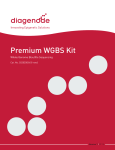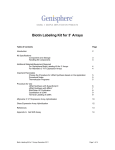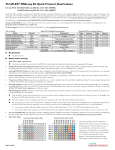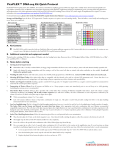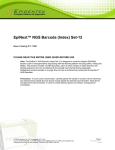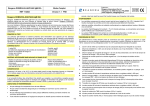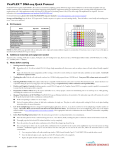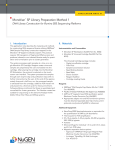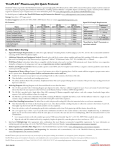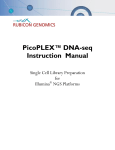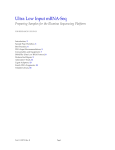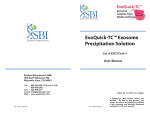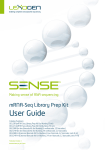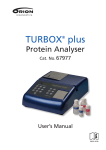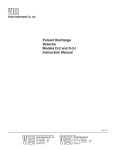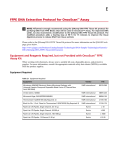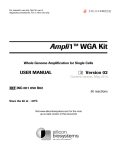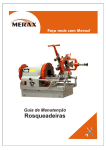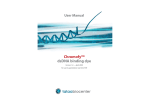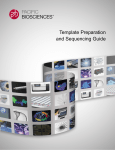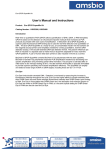Download ThruPLEX®-FD Prep Kit Instruction Manual
Transcript
ThruPLEX®-FD Prep Kit Instruction Manual Single Tube Library Preparation for Illumina® NGS Platforms Contents Product Description ...................................................................................................................... 2 Kit Contents ........................................................................................................................................................ 2 Shipping and Storage ......................................................................................................................................... 2 Getting Started ............................................................................................................................. 3 Input DNA Sample Requirements .................................................................................................................. 3 Index Sequences.................................................................................................................................................. 3 Required Materials and Equipment................................................................................................................. 4 Optional Materials .............................................................................................................................................. 4 ThruPLEX-FD Prep Kit Protocol ................................................................................................ 5 A. Template Preparation ................................................................................................................................... 5 B. Library Synthesis ............................................................................................................................................ 5 C. Library Amplification .................................................................................................................................... 6 D. ThruPLEX®-FD Prep Kit Library Quantification.................................................................................... 7 E. Pooling ThruPLEX-FD Prep Kit Libraries Prepared with Different Indices ..................................... 9 F. ThruPLEX-FD Prep Kit Library Purification or Size Selection ............................................................ 9 G. Sequencing ThruPLEX-FD Prep Kit Libraries ...................................................................................... 10 Troubleshooting Guide ............................................................................................................... 11 Technical Support ............................................................................................................................................. 11 QAM-132-001 1 Product Description ThruPLEX®-FD Prep Kit converts double-stranded DNA (dsDNA) or cDNA samples into sequencing-ready libraries for Illumina® Next-Generation Sequencing (NGS) platforms. Highly efficient patented stem-loop adaptor chemistry allows for use of smaller input amounts and eliminates intermediate purification steps, thus reducing the time to results. For more information visit: www.rubicongenomics.com/products/thruplex/ ThruPLEX-FD Workflow Kit Contents Table 1: ThruPLEX-FD Prep Kit contents Name Template Preparation Buffer Template Preparation Enzyme Library Synthesis Buffer Library Synthesis Enzyme Library Amplification Buffer Library Amplification Enzyme Nuclease-Free Water Indexing Reagent 1-12 User Manual Cap Color Red Red Yellow Yellow Green Green Clear Violet 12 Reaction Kit CAT. NO: R40012 1 Tube 1 Tube 1 Tube 1 Tube 1 Tube 1 Tube 1 Tube 12 Tubes 48-Reaction Kit CAT. NO: R40048 1 Tube 1 Tube 1 Tube 1 Tube 2 Tubes 1 Tube 1 Tube 12 Tubes The volumes of components provided in the kit are sufficient for the preparation of up to 12 reactions for R40012 and up to 48 reactions for R40048. Shipping and Storage ThruPLEX-FD Prep Kit is shipped on dry ice. The kit should be stored at -20°C upon arrival. QAM-132-001 2 Getting Started Input DNA Sample Requirements Sample Nucleic acid Molecular weight Input volume Input amount Recommended Fragmented double-stranded DNA < 1000 bp 10 μL 50 pg – 50 ng Starting Material Fragmented double-stranded DNA (gDNA or cDNA), chromatin immunoprecipitates (ChIP), degraded DNA from sources such as biofluids or FFPE are suitable. This kit is not for use with single-stranded DNA (ssDNA) or RNA. Optimal DNA fragment size ThruPLEX-FD Prep Kit is a ligation-based technology and adapters added during the process result in an approximately 120 base pair increase in the size of each DNA template fragment. DNA fragments less than 1 kb will be more efficiently sequenced than fragments greater than 1 kb. Input Volume If a sample is in a larger volume, the DNA can be concentrated into 10 µL or less. Alternatively, the sample may be split into 10 µL aliquots, processed in separate tubes, and the corresponding products pooled prior to the purification step preceding sequencing (Sections E & F). Recommended Input Amount for Obtaining Optimal Data For Whole Genome Sequencing (WGS) and Whole Exome Sequencing (WES) using human gDNA or plasma DNA, 20 ng of input DNA is recommended to achieve a highly diverse library. More damaged samples, such as FFPE, may require greater input amounts. For sequencing samples with reduced complexity such as cDNA, ChIP DNA, bacterial DNA, or targeted genomic regions, lower input amounts (picogram levels) can be used. Index Sequences Index 1 2 3 4 5 6 QAM-132-001 Sequence ATCACG CGATGT TTAGGC TGACCA ACAGTG GCCAAT Index 7 8 9 10 11 12 Sequence CAGATC ACTTGA GATCAG TAGCTT GGCTAC CTTGTA 3 Required Materials and Equipment Thermal cycler with 75 µL reaction volume capability and heated lid PCR tubes or 96-well PCR plate and seal Aerosol barrier pipette tips Agencourt® AMPure® XP (Beckman Coulter, CAT. NO. A63880) Optional Materials Quant-iT™ PicoGreen® dsDNA Assay Kit (Life Technologies, CAT. NO. P7589) EvaGreen® Dye, 20X in water (Biotium, CAT. NO. 31000) Library Quantification Kit/Illumina (KAPA Biosystems) QAM-132-001 4 ThruPLEX-FD Prep Kit Protocol Template Preparation Enzyme, Library Synthesis Enzyme, and Library Amplification Enzyme should be quick-spun and transferred to ice immediately prior to use. All remaining components should be thawed on ice, briefly vortexed, and quickspun prior to use. All reagents and master mixes should be kept on ice. A. Template Preparation 1. Add 10 µL of each DNA sample to a PCR tube or well. Negative Control (no DNA) should be run in parallel; use 10 µL of nuclease-free water in place of DNA Positive control (sheared DNA) may also be run in parallel 2. In a separate tube on ice, prepare the Template Preparation Master Mix as described in the table below for the chosen number of reactions. Mix thoroughly by pipette. Keep on ice until used. Template Preparation Master Mix Component Cap Color Volume/Reaction Template Preparation Buffer Red 2.0 μL Template Preparation Enzyme Red 1.0 μL 3. Add 3 µL of the Template Preparation Master Mix to each 10 µL DNA sample. 4. Mix by pipetting 5 times with pipette set to 8 µL. 5. Centrifuge the tube(s) or plate briefly to ensure entire volume is collected at the bottom of each tube or well. 6. Place the tube(s) or plate in a thermal cycler with a heated lid (> 100°C). Perform the Template Preparation Reaction using the protocol in the table below. Template Preparation Reaction Temperature Time 22°C 25 min. 55°C 20 min. 4°C Hold up to 2 hours 7. Important: Centrifuge the tube(s) or plate for 1 min at room temperature. B. Library Synthesis 1. Immediately prior to use, prepare the Library Synthesis Master Mix in a separate tube as described in the table below for the chosen number of reactions and mix thoroughly by pipette. Keep on ice until used. Library Synthesis Master Mix Component Cap Color Volume/Reaction Library Synthesis Buffer Yellow 1.0 μL Library Synthesis Enyzme Yellow 1.0 μL 2. Add 2 µL of the Library Synthesis Master Mix to each sample. QAM-132-001 5 3. Mix by pipetting 5 times with pipette set to 10 µL. 4. Centrifuge the tube(s) or plate briefly to ensure entire volume is collected at the bottom of each tube or well. 5. Incubate the tube(s) or plate in a thermal cycler with a heated lid (> 100°C). Perform Library Synthesis Reaction using the protocol in the table below. Library Synthesis Reaction Temperature Time 22°C 40 min. 4°C Hold up to 30 min. 6. Centrifuge the tube(s) or plate before proceeding to Step C.1. C. Library Amplification 1. Use the table below to determine the number of cycles required for ▲ Stage 5 of the Library Amplification Reaction. Note: DNA extracted from formalin-fixed material may require extra PCR cycles. Input DNA (ng) 50 20 10 2 1 0.2 0.05 ▲ Stage 5 Amplification Cycles 5 7 8 11 12 16 18 2. Program your thermal cycler for Library Amplification Reaction according to the table below using the recommended number of cycles for ▲ Stage 5. Caution: Ensure that the cycler does not have a denaturing step programmed until Stage 3. Stage 1 2 3 4 ▲ 5 6 Library Amplification Reaction Number of Cycles Temperature 1 72°C 1 85°C 1 98°C 98°C 4 67°C 72°C 98°C ▲ 5 – 18 * 72°C 1 4°C Time 3 min. 2 min. 2 min. 20 sec. 20 sec. 40 sec. 20 sec. 50 sec. hold * Acquire real-time data at this step if using a real-time thermal cycler. QAM-132-001 6 3. Immediately prior to use, prepare the Library Amplification Master Mix in a separate tube as described in the table below for the chosen number of reactions. Keep on ice until used. Library Amplification Master Mix Component Cap Color *Nuclease-Free Water (plus Optional Dye) Clear Library Amplification Buffer Green Library Amplification Enzyme Green Volume/Reaction 8.0 μL 48.5 μL 1.5 μL * If monitoring the library in real-time, the volume of fluorescent dye and calibration dye (both diluted in nuclease-free water as needed) plus water should not exceed 8 µL. Note that the total reaction volume is 75 µL. EvaGreen Dye (Biotium), the preferred dye for ThruPLEX-FD Prep Kit chemistry, should be added at 1x final concentration or SYBR® Green I dye (Life Technologies) at 0.1x final concentration. 4. Mix the Library Amplification Master Mix by briefly vortexing and add 58 µL to each tube or well. 5. Add 2 µL of one Indexing Reagent (1 – 12) to each sample; mix 4 times with a pipette set to 50 µL. 6. Centrifuge the tube(s) or plate briefly to ensure entire volume is collected at the bottom of each tube or well. 7. Transfer the tube(s) or plate to a thermal cycler with a heated lid (> 100°C), perform Library Amplification Reaction according to the program in Step C.2. 8. Store samples at 4°C overnight or up to seven days at -20°C. QAM-132-001 7 D. ThruPLEX-FD Prep Kit Library Quantification Recommended Quantification Method (Non-destructive Method) 1. Quantify ThruPLEX-FD libraries via real-time qPCR by diluting 2-5 µL of the library using a 100,000-fold dilution. Note: No purification of the samples is necessary prior to qPCR due to the large dilution factor. KAPA Library Quantification Kit for Illumina is recommended for library quantification. If preparing libraries from similar samples with equalized inputs, equal volumes of each library can be pooled and then purified as described in Section F. 2. If the qPCR results show less than desirable yield, the remaining library can be further amplified to attain a higher yield (unless a plateau has been reached). The additional amplification can only be performed on unpurified libraries. To perform this additional amplification, spin down a tube or plate containing the library, transfer it to a thermal cycler, and perform 2-3 PCR cycles as follows: Number of Cycles 2 - 3 cycles 1 cycle Temperature 98°C 72°C 4°C Time 20 sec. 50 sec. hold Note: ThruPLEX-FD libraries quantified by this method can be pooled according to Section E, and then purified according to Section F. The pooled libraries should be quantified after purification prior to sequencing to achieve efficient clustering. QAM-132-001 8 Alternative Quantification Methods (Post-purification, Section F) ThruPLEX-FD libraries can be quantified by Agilent Bioanalyzer®, Qubit® (Life Technologies), NanoDrop™ (Thermo Fisher Scientific, Inc.), and similar UV absorption or fluorescence-based protocols. Barcoded libraries can be pooled at a desired molar ratio prior to sequencing (Section E). E. Pooling ThruPLEX-FD Prep Kit Libraries Prepared with Different Indices Individual libraries quantified according to Section D can be pooled at desired molar ratios to allow multiplex sequencing of the pooled library. The pooled libraries should be prepared with different indices. If using fewer than 12 indices; follow Illumina Multiplexing Sample Preparation Guide (Part # 1005361 Rev.D, page 39). F. ThruPLEX-FD Prep Kit Library Purification or Size Selection 1. Gel-Free Library Purification by AMPure XP – Optimized for ThruPLEX-FD Note: AMPure XP sample purification is not necessary if size-selection is performed (Section F.2). AMPure XP is the preferred method of library purification to preserve sequence complexity. Do not use QIAquick® cleanup or other silica-based filters for purification as this will result in an incomplete removal of primers. Mixing the sample(s) and the AMPure XP reagent at a 1:1 ratio is critical. 1. Bring all the samples and reagents to room temperature. In the meantime, prepare fresh 80% ethanol (enough for steps 7 and 10 below). 2. Resuspend the AMPure XP reagent by light vortexing until no visible pellet is present at the bottom of the container. 3. In a 1.5 mL tube, mix the sample library and the AMPure XP reagent at a 1:1 ratio. Mix by pipette 10 times to achieve a homogeneous solution. 4. Incubate the solution at room temperature for 5 min. 5. Pulse-spin* the sample(s), place into a magnetic stand, and wait for 2 min or until the beads are completely bound to the side of the tube(s) and the solution is clear. 6. While keeping the sample(s) in the magnetic stand, use a pipette to aspirate off and discard the supernatant without disturbing the pellet. 7. Add 300 µL of freshly prepared 80% ethanol. 8. With the sample(s) in the magnetic stand, turn each tube clockwise - not end over end – 90 degrees and wait until all the beads come to a halt. Repeat this step three more times. Note: When using a plate/strips turn the plate/strips 180 degrees for a total of four times, or skip step 8 and proceed to step 9. 9. With the sample(s) in the magnetic stand, use a pipette to aspirate off and discard the supernatant without disturbing the pellet. 10. Add 300 µL of freshly prepared 80% ethanol. 11. With the sample(s) in the magnetic stand, turn each tube clockwise - not end over end - 90 degrees and wait until all the beads come to a halt. Repeat this step three more times. Note: When using a plate/strips turn the plate/strips 180 degrees for a total of four times, or skip step 11 and proceed to step 12. 12. With the sample(s) in the magnetic stand, use a pipette to aspirate off and discard the supernatant without disturbing the pellet. QAM-132-001 9 13. Pulse-spin* the sample(s), place into a magnetic stand, and wait for 2 min or until the beads are completely bound to the side of the tube(s). 14. While keeping the sample(s) in the magnetic stand, use a pipette to aspirate off and discard any residual ethanol without disturbing the pellet. 15. Leaving the cap open, incubate the sample(s) in a heating block at 37°C for 2 – 3 min or until the pellet is dry. 16. Elute the DNA by resuspending the beads with 20 – 50 µL of 1x TE buffer, pH 8.0. 17. Pulse-spin* the tube(s) and place it into a magnetic stand and wait for 2 min or until the beads are completely bound to the side of the tube(s) and the solution is clear. 18. With the sample(s) in the magnetic stand, without disturbing the pellet, transfer the supernatant with a pipette into a new tube. 19. If not used immediately, store the purified library at -20°C. * Pulse-spin the sample(s) using a low speed, benchtop, centrifuge. 2. Library Purification by Gel Size Selection (Optional) Note: Gel size selection is not necessary if AMPure XP sample purification is performed (Section F.1). ThruPLEX-FD libraries can be size-selected prior to sequencing using agarose gel electrophoresis as described in the Illumina Paired-End Sample Preparation Guide (Illumina Document 1005063), Illumina TruSeq™ DNA Sample Preparation Guide (Illumina Catalog # PE-940-2001, Part # 15005180), or by using automated platforms such as LabChip® (Caliper Life Sciences), Pippin Prep™ (Sage Science), or a similar technology. When using agarose gel electrophoresis, extraction of the DNA should be performed with QIAquick® Gel Extraction Kit (Qiagen, Part # 28704), or MinElute® Gel Extraction Kit (Qiagen, Part # 28604) following the manufacturer’s instructions. Note: The adapters added during the ThruPLEX-FD Prep Kit process result in an approximately 120 base pair increase in the size of each library. G. Sequencing ThruPLEX-FD Prep Kit Libraries The ThruPLEX-FD Prep Kit generates libraries which are ready for cluster amplification and sequencing on the Illumina Genome Analyzer, HiSeq, or MiSeq platforms using standard Illumina clustering & sequencing reagents and protocols for multiplexed libraries. Follow Illumina’s loading recommendations. Note: In order to set up a sample sheet for paired-end sequencing, choose paired-end option, add a sample entry, choose I7, and finish by adding all the used indices: A001 - A012. Compare each sequence added to the sequences listed on page 3 of this manual. Structure of ThruPLEX-FD Libraries 5´ AATGATACGGCGACCACCGAGATCTACACTCTTTCCCTACACGACGCTCTTCCGATCT------------Insert---------3´ TTACTATGCCGCTGGTGGCTCTAGATGTGAGAAAGGGATGTGCTGCGAGAAGGCTAGA-------------Insert---------------Insert-------AGATCGGAAGAGCACACGTCTGAACTCCAGTCACATCACGATCTCGTATGCCGTCTTCTGCTTG 3´ -------Insert-------TCTAGCCTTCTCGTGTGCAGACTTGAGGTCAGTGTAGTGCTAGAGCATACGGCAGAAGACGAAC 5´ Index 1 QAM-132-001 10 Troubleshooting Guide Problem Sample amplification curve looks like No Template Control (NTC) amplification curve or does not produce amplified product NTC amplification curve appears early or produces a yield similar to sample reaction products Sample Bioanalyzer traces show multiple peaks, after efficient cleanup: Potential Cause No input DNA was added Quantitate input before using the kit Incorrect library template was used (e.g. RNA/ssDNA) Adhere to DNA Sample Requirements for input specifications (p. 3) NTC is contaminated with DNA Use a fresh control solution and check all reagents Work area is contaminated with DNA Clean area thoroughly and use PCR-dedicated plastics and pipettes Kit has been contaminated with DNA Use a fresh kit Check thermal cycler; reaction is not being cycled properly Check that the thermal cycler can accommodate 75 µL reactions. If not, switch to a cycler that can. Peaks < 120 bp Peaks < 1000 bp Peaks < 1000 bp and > 1000 bp Suggested Solutions Reaction was started with unevenly fragmented DNA of various fragment sizes (e.g. plasma DNA) Library overamplified or Bioanalyzer chip is overloaded (common for high sensitivity chips) If possible, quantify and check the input DNA prior to using kit. Sequencing is still recommended. Perform fewer PCR cycles at Stage 5, C.1. For high sensitivity chips, load ≤ 7ng/µL. Sequencing is still recommended. Technical Support For technical support contact [email protected] or call +1.734.677.4845 (9 AM – 5:30 PM EST). QAM-132-001 11 Product Use Limitations ThruPLEX-FD Prep Kit* is intended for Research Use Only. It may not be used for any other purpose including, but not limited to, use in diagnostics, forensics, therapeutics, or in humans. ThruPLEX-FD Prep Kit may not be transferred to third parties, resold, modified for resale or used to manufacture commercial products without prior written approval of Rubicon Genomics, Inc. *Protected by U.S. Patents 7,803,550; 8,071,312; 8,399,199; 8,728,737 and corresponding foreign patents. Additional patents are pending. The index sequences correspond to Illumina Index sequences for multiplexing and are copyrighted to Illumina, Inc. Oligonucleotide sequences© 2007-2012 Illumina, Inc. All rights reserved. Agencourt® and AMPure® XP are registered trademarks of Beckman Coulter, Inc. Bioanalyzer® is a registered trademark of Agilent Technologies, Inc. EvaGreen® is a registered trademark of Biotium, Inc. Illumina® is a registered trademark of Illumina, Inc. LabChip® is a registered trademark of Caliper Life Sciences, Inc. MinElute® and QIAquick® are registered trademarks of Qiagen. NanoDrop™ is a trademark of Thermo Fisher Scientific, Inc. Pippin Prep™ is a trademark of Sage Science, Inc. Quant-iT™ PicoGreen®, Qubit®, and SYBR® are registered trademarks of Life Technologies Corporation. ThruPLEX® is a registered trademark of Rubicon Genomics, Inc. TruSeq® is a registered trademark of Illumina, Inc. QAM-132-001 12 4743 Venture Drive, Ann Arbor, MI 48108 T +1.734.677.4845 F +1.734.477.9902













